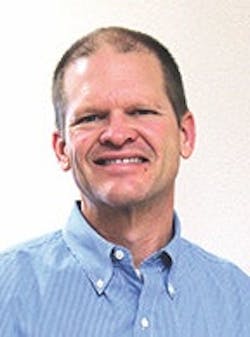I cannot believe it is already November. Where has 2016 gone? November is a peculiar month to me. If you recall, last month we discussed the topic of a customer’s perception. November is one of those months customers assume we are not as busy, but the reality is November, especially the end of November, is a busy time.
I remember several years ago when the busiest time of the whole year was the week before Thanksgiving through the week of Christmas. Customers would bring their vehicles in for service because they were taking a holiday vacation, and they would be shocked we were so busy. I would always smile to myself when customers would tell me they were going to see Grandma for the holidays, and the customers were amazed other people were also traveling for the holidays. I hope you had a chance during your shop meeting last month to discuss the customer’s perception, because we all know perception is reality.
2016 has been a good year in the quick lube industry. Looking at the 2016 Operator Survey in the September issue of National Oil and Lube News, there has been growth in several key areas that reflects a positive and healthy industry. Gauging from the number of phone calls I have received, there are a lot of new owners in the industry, which I think is a good sign. There is new blood with vigor to offer top-notch service to our customers.
It is interesting that new car dealerships are coming into the industry at a breathtaking speed. From the statistics I have seen, the original equipment manufacturers (OEMs) are the fastest-growing segment in the quick maintenance industry, and I am not talking about the dealerships that offer a lowball oil change price to get people in the shop and then try to upsell the consumers. These new competitors are putting in bays dedicated to changing oil and other services typically found in the quick lube. Some industry experts see this influx of new car dealerships into the market as a sign indicating how healthy the quick lube industry is and how important routine maintenance is for today’s vehicles.
These new members of the quick lube club have structured the oil change to become a profit center to the dealership and to assist them as they build relationships with their customers. Another good sign regarding the health of the quick lube industry is the number of acquisitions taking place. Several large organizations have plans in place to continue to purchase smaller shops to create a stronger presence in the market. But the most encouraging sign of a strong industry is the number of first-time owners. I have been in contact with these new owners. One of the first questions I get is, “What is a typical daily schedule for a quick lube?”
I try to explain there is no such thing as typical, but in general, here it is:
Daily Schedule of a Quick Lube
8 a.m. to 6 p.m. Monday Through Saturday
7:30 a.m.
Manager arrives, ready to work.
It is important for the manager to set the tone for what is expected from a company policy standpoint. The manager must be on time, in uniform and ready to work. The manager is a visual example of the company policy.
As the manager arrives at the shop, they should visually check for and pick up any trash or debris around the parking area and drive. A quick visual check and tending to any landscaping needs that may portray the wrong impression to the customers is also important. Next, the manager will open the shop, turn off the alarm, turn on all the lights and turn on the air compressor. Preferably, the manager opens the safe and counts that day’s opening cash. Once the opening cash has been verified, it should be entered into the point-of-sale (POS) system as startup procedures are performed.
Now that the shop is ready to open, it is time to check the deposit from the day before and confirm the end-of-day reports from the previous day achieved the shop’s expectations. Then, file the report and adjust any expectations for today’s business. After the register is filled and the start-of-day procedures are finished, it is time to turn on the other POS stations and verify the entire system is up and running.
7:45 a.m.
The first-shift staff arrives (8:00 am-4:30pm), ready to work and also in compliance with company policy. The staff will clock in or use the POS to record they are ready for work. Now that they are clocked in, they should organize the work area, making sure all tools and equipment are clean and ready to use. Now that the workstations and bays are clean and ready to operate, it is time to organize and restock inventory, placing the new items in the back of shelves and older items in the front. While the upper bay technicians complete the topside responsibilities, the lower bay crew will discard the drained used filters from the day before in the used filter containers and restock the oil filter shelves.
7:55 a.m.
Regardless if customers have arrived or not, open doors and turn on the open sign. If customers arrive before the official opening time, open the bay door, greet customers and let them know you will get started soon.
8 a.m. - 6 p.m.
During the normal hours of operation, each team member has responsibilities to the shop. Some may keep the floors mopped and spills cleaned up. Others will keep inventory organized while someone else keeps the trash empty and the customer restrooms clean. The second-shift crew arrives at 10:00am and will work until 6:00p.m.
A well-organized shop will cross-train every employee so everyone has a primary duty and a secondary duty. That way, when an employee finishes with their first job, they can pitch in and complete the secondary job. Every technician also has a responsibility to the shop. As an example, the upper bay technician completes the work under the hood (first duty) and then can help check tire pressure (second duty.) Once the first and second duties have been completed, then the same technician can restock the air filter shelves — a responsibility to the shop. Each person has a first and second job to be performed and a responsibility to the shop.
5:50 p.m.
Close to the end of the day, the staff begins end-of-day cleanup. Trash should be taken out, red rags placed in the proper container, tools wiped down and put back in place and the entire shop swept and mopped with clean water and mop heads.
6 p.m.
The staff member who functioned as the cashier during the day will perform the end-of-day procedures and enter the information in the POS software. Most organizations that deal with cash recommend having two different people count the cash. If two people are counting, it minimizes mistakes, and as an added benefit, lessens the temptation of theft. It is a recommendation that one of those two people be a manager, and since the manager is counting in the morning, another staff member can count at night. Once the money has been counted and accounted for, put the deposit money in a safe place — preferably in a secured safe — and put the opening day cash in a separate bag, also placed in the secured safe for the night.
6:15 p.m.
As long as there are no customers in the shop, it is time to close the shop for the day. The cashier, or possibly the manager, will turn off the lights and the compressor (opening the water valve) and make sure all the doors are down and locked. Then, turn on the alarm, and lock up shop for the night.
Before you all write in to tell me, “Wouldn’t it be great if this is the way it was?” I already stated there is no such thing as a typical day, and obviously I didn’t go into great detail. However, this schedule of daily events is a pretty good standard of how a day should run.
Most importantly, November is a month to be thankful. 2016 has had its ups and downs, but in the end, it has been a good year. Thank you all for everything you do to make this industry the great one it is.
About the Author

